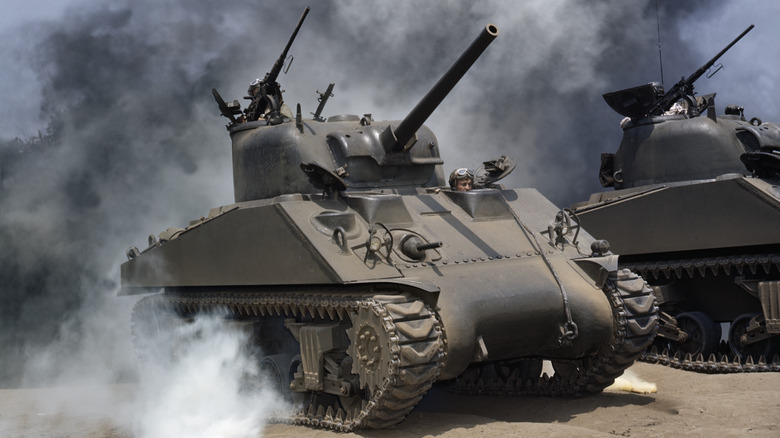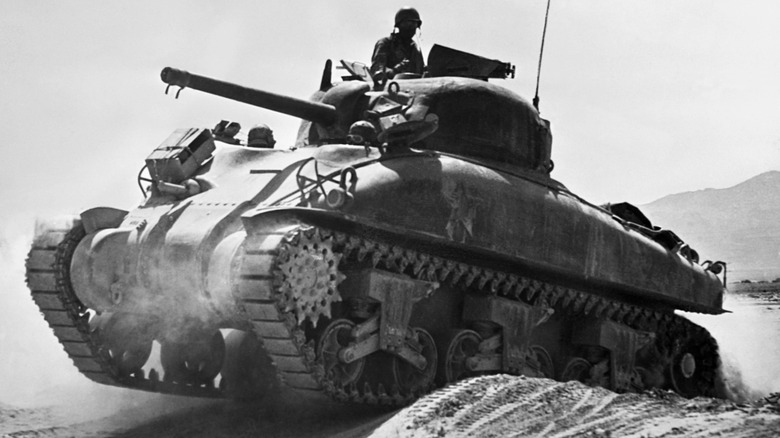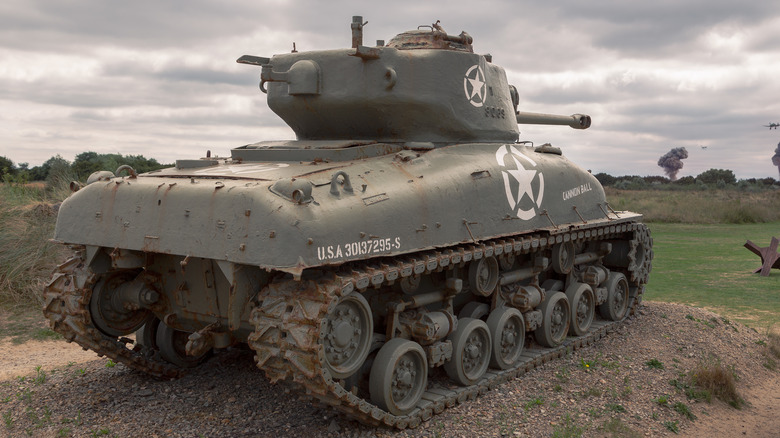The Biggest Strengths And Weaknesses Of America's M4 Sherman Tank
When the U.S. got involved in WWII, one thing it had in short supply was tanks. The M2 failed to meet expectations, becoming obsolete right off the assembly line. It wasn't used in combat operations, while its successor, the M3 Lee was used as a stopgap measure while the development of another tank commenced. That replacement armor was the M4 Sherman, and it became the workhorse of the U.S. Army's armor units deployed throughout the theater of operations of WWII.
Designers used what worked and abandoned what didn't from the M3 while focusing on making an armored vehicle that was easy to produce, train, and operate. By the end of the conflict, the U.S. produced over 50,000 M4s of varying types because, like many military vehicles, the M4 was highly customizable for a variety of purposes. The M4 was also a popular tank for the Lend-Lease Act, enabling Allied partners to take possession and operate them during WWII.
M4s went to the Chinese, Free French, U.K., and Soviet Union, where they were tested on battlefields across the globe. While the M4 proved itself in combat throughout the latter half of WWII, like any purpose-built, rapidly produced piece of equipment, it had its pros and cons. Fortunately, the pros outweighed the cons, ensuring the M4 remains one of the military's most successful land combat vehicles, but it's fair to say it had enough cons that people took notice.
The M4 dominated the battlefields of WWII
The M4 boasted many features and advancements over previous tank models in the U.S. inventory. Its key strength was something few consider who don't climb in and out of tanks on a daily basis — maintenance. Maintaining armored vehicles in combat operations is expensive and time-consuming, but the M4 was a beast. Historian David Fletcher described the M4 to The Tank Museum (via YouTube): "It would always start in the morning; it would go all day." Reliability on the battlefield is imperative for mission success, and the M4's track record speaks for itself.
The M4 drastically improved its design over the M3 by moving its main gun from a side sponson to a 360-degree traversing top-mounted turret. This design wasn't possible with the M3 but was implementable for the M4. The caliber remained the same: A 75 mm gun was the standard for light and medium tanks. By the time the M4 entered production, 75 mm guns had proven effective against German light and medium tanks, so outfitting it on the new tank design was a no-brainer.
Future variants incorporated a slightly larger and more lethal 76 mm gun with a shorter barrel, allowing for the firing of the T4 High-Velocity Armor-Piercing (HVAP) round. These could penetrate the armor of enemy tanks from normal range, ensuring the M4 maintained a lethal presence on the battlefield. In addition to its main gun, M4s sported two .30 caliber M1919 machine guns and a .50 caliber Browning M2, used for anti-aircraft protection.
For its many strengths, the M4 had several weaknesses
For the most part, the M4 Sherman was a reliable medium, 30-ton tank with a proven track record against light and medium armor. That said, it had a few weaknesses that caused problems in and out of combat. When it entered combat in North Africa, tankers learned very quickly that the M4 was prone to bursting into flames once hit. While the tank could survive an initial impact, the resulting fire disabled or destroyed the tank while endangering everyone inside.
Fortunately, the M4 featured a floor escape hatch, but this presented another weakness. If it was open when the tank took a hit, the fire burned faster and hotter, so tankers welded these shut before combat operations. Once the escape hatch was welded, the M4's crew survivability increased substantially. Another problem with the M4 was its track width, which made it susceptible to getting stuck in the mud. Because mud was a common sight in multiple theaters of WWII, this became a logistics and mechanical problem relatively often.
Another problem with the M4 was its high silhouette, which is something it inherited from the M3. The M4's high profile of at least 9 feet limited the tank's effectiveness in several ways. Primarily, it made the tank easier to target and fire upon. Lastly, the M4 couldn't fire its main gun with much accuracy while moving despite having a stabilizer, though this wasn't uncommon for the period. Despite these weaknesses, the M4 remains one of the most-produced and battle-tested tanks in U.S. history, and it continued operating long after WWII came to an end.


